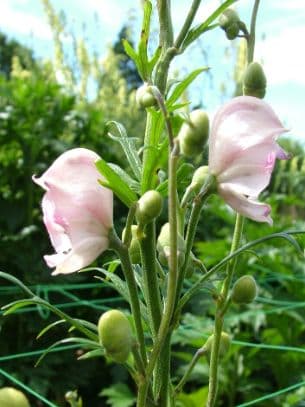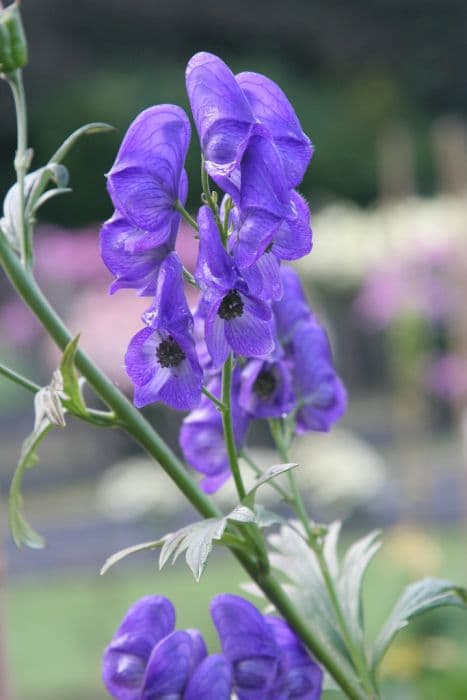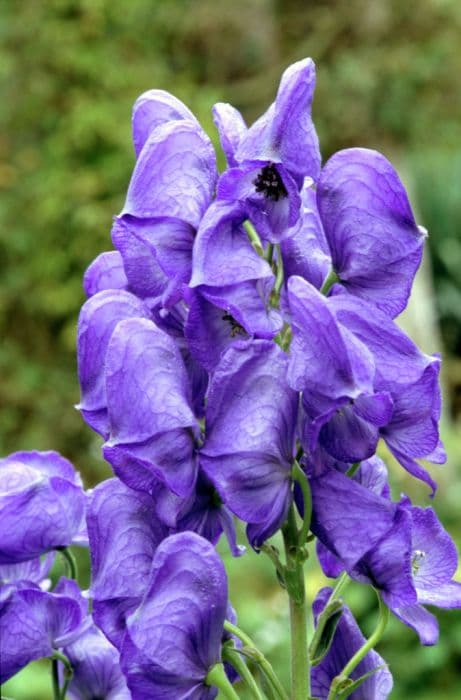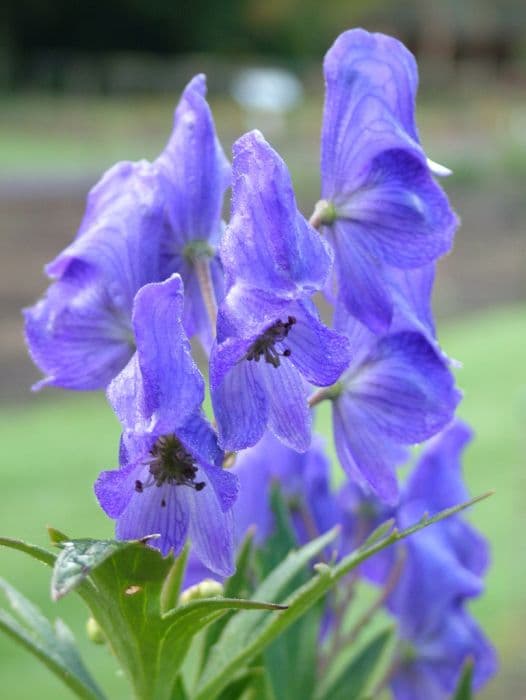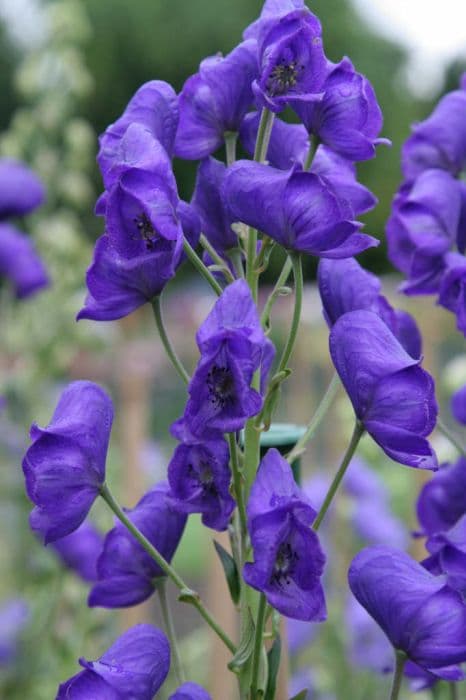Clematis General Sikorski Clematis 'General Sikorski' (EL)

ABOUT
General Sikorski clematis is a stunning perennial vine known for its large, showy flowers. These blooms are a rich lavender-blue, often with a slightly paler bar in the center of each petal, contrasting beautifully against the green foliage. The petals are broad and slightly overlapping, creating an almost star-like shape to the blossoms that can appear quite plush and luxurious. The flowers are not only remarkable for their color and form but also for their prominent stamens, which typically have a creamy yellow to white appearance, offering a striking center. The stamens add an extra layer of texture and visual interest, drawing both the eyes and pollinators alike. Aside from the spectacular flowers, the vine's foliage is worth noting. The leaves are bright green, adding a lush backdrop for the floral display. They are divided into multiple leaflets, which radiate out from a central point, creating an attractive, compound structure that has both a delicate and full-bodied presence on the vine. Throughout the blooming season, General Sikorski clematis tends to produce an abundance of these flowers, which can create a dramatic and eye-catching display, especially when trained on trellises, walls, or other supports that let the plant showcase its natural climbing habit. Despite its impressive floral show, General Sikorski clematis is not particularly fragrant, relying more on its visual charm to capture the attention of onlookers and garden enthusiasts. Its appearance alone makes it a favorite among gardeners looking to add vertical interest and a touch of elegance to their outdoor spaces.
About this plant
 Names
NamesFamily
Ranunculaceae
Synonyms
General Sikorski Clematis
Common names
Clematis 'General Sikorski' (EL).
 Toxicity
ToxicityTo humans
Clematis, including the Clematis 'General Sikorski', can be toxic to humans if ingested. The plant contains glycosides that can cause digestive upset and other symptoms. Upon ingestion, an individual may experience symptoms such as nausea, vomiting, diarrhea, and excessive salivation. In more severe cases, there could be signs of mouth irritation and ulcers. It is generally recommended to avoid consuming any part of the clematis plant.
To pets
Clematis is also toxic to pets such as dogs and cats. Similar to humans, if pets ingest parts of the plant, they may suffer from symptoms including vomiting, diarrhea, hypersalivation, and possible irritation to the mouth. In severe cases, ingestion can result in more serious health issues such as a drop in heart rate or muscle tremors. It is advisable to prevent pets from chewing on or ingesting clematis to avoid these toxic effects.
 Characteristics
CharacteristicsLife cycle
Perennials
Foliage type
Deciduous
Color of leaves
Green
Flower color
Lavender
Height
10 feet (3 meters)
Spread
3 feet (0.9 meters)
Plant type
Climber
Hardiness zones
4
Native area
Europe
Benefits
 General Benefits
General Benefits- Attractive Flowers: Clematis 'General Sikorski' boasts large, lavender-blue flowers that add aesthetic appeal to any garden.
- Seasonal Interest: This plant blooms profusely from late spring to early summer, providing seasonal interest.
- Climbing Habit: As a climbing vine, it can be used to cover trellises, walls, or fences, enhancing vertical spaces in the garden.
- Pruning Flexibility: It belongs to pruning group 2, which means it is relatively easy to care for and can be pruned lightly.
- Wildlife Attraction: The flowers can attract beneficial pollinators such as bees and butterflies to the garden.
 Medical Properties
Medical PropertiesThis plant is not used for medical purposes.
 Air-purifying Qualities
Air-purifying QualitiesThis plant is not specifically known for air purifying qualities.
 Other Uses
Other Uses- Clematis 'General Sikorski' can be utilized in artistic arrangements, providing long-lasting color and form in dried floral displays.
- The vine's sturdy structure allows it to be trained into various shapes, making it a natural choice for topiary art in garden design.
- Its vibrant blooms can serve as a natural dye for fabrics, offering hues of purples and blues.
- This clematis can be grown in large containers to decorate balconies and terraces where ground planting isn't an option.
- In photography, the intricate structure and striking colors of Clematis 'General Sikorski' make it an excellent subject for macro photography.
- Classes on gardening can use this clematis as a specimen to teach pruning techniques specific to vine plants.
- Its growth can be directed to create living curtains or privacy screens in outdoor living areas.
- Educational programs on pollinators can include this plant to demonstrate the role of flowers in supporting bee populations.
- It can be used as part of rehabilitation programs in therapeutic horticulture settings, promoting physical activity through gardening.
- The plant's climbing habit can be employed to cover unsightly structures, integrating them more naturally into the landscape.
Interesting Facts
 Feng Shui
Feng ShuiThe Clematis is not used in Feng Shui practice.
 Zodiac Sign Compitability
Zodiac Sign CompitabilityThe Clematis is not used in astrology practice.
 Plant Symbolism
Plant Symbolism- Ingenuity: Clematis, in general, is associated with cleverness and intellectual achievement, reflecting the resourceful character of 'General Sikorski'.
- Artistic Inspiration: The striking flowers of the 'General Sikorski' clematis often symbolize creativity and the muse's influence on artists and thinkers.
- Mental Beauty: The clematis represents the beauty of the mind, alluding to 'General Sikorski' as an individual of great intellect and strategy.
- Traveler's Joy: This common name for clematis nod to the plant's propensity to grow and climb, aligning with the adventurous spirit and journeys of its namesake military leader.
 Water
WaterClematis 'General Sikorski' should be watered deeply once a week, allowing the soil to dry out somewhat between waterings. This typically equates to about 1 gallon of water per week for each plant, although this amount may need to be increased during particularly dry or hot periods. Ensure that water is applied directly to the base of the plant to avoid wetting the foliage, which can lead to fungal diseases. It is crucial to maintain consistent moisture throughout the growing season, especially when plants are establishing in the first couple of years after planting. During winter, watering can be reduced as the plant is dormant.
 Light
LightClematis 'General Sikorski' flourishes best in a location that receives full sun to partial shade. Aim to provide the plant with at least six hours of sunlight daily; however, it is beneficial to protect the plant's base from intense afternoon sun. This can be achieved by shading the root area with other plants or mulch. The ideal spot combines morning sunlight with dappled or partial shade in the afternoon to prevent overheating.
 Temperature
TemperatureClematis 'General Sikorski' performs well in a wide range of temperatures, thriving in USDA hardiness zones 4 through 8. It can withstand minimum temperatures down to -30°F in winter but prefers warmer conditions during its growing season. The ideal temperature range for this plant is between 55°F and 75°F. Extremes of heat or cold outside this range may adversely affect plant health and flowering.
 Pruning
PruningPruning Clematis 'General Sikorski' is necessary to promote vigorous growth and abundant blooms. It should be pruned in late winter or early spring before new growth begins but after the threat of hard frost has passed. Remove any dead or weak stems and prune the remaining stems back to a pair of strong buds, typically 6 to 9 inches above ground level. 'General Sikorski' belongs to pruning group 2, meaning light pruning is appropriate as it flowers on both last year's growth and the current season's growth.
 Cleaning
CleaningAs needed
 Soil
SoilFor Clematis 'General Sikorski', the best soil mix is well-draining, fertile loam with added compost or well-rotted manure. Aim for a slightly alkaline to neutral pH, around 7.0.
 Repotting
RepottingGeneral Sikorski Clematis should be repotted every two to three years, or when it outgrows its current container.
 Humidity & Misting
Humidity & MistingClematis 'General Sikorski' prefers outdoor humidity conditions and doesn't have specific humidity requirements when grown outside.
 Suitable locations
Suitable locationsIndoor
Provide bright, indirect light and cool temperatures.
Outdoor
Plant in sun to part shade, provide support for climbing.
Hardiness zone
4-9 USDA
 Life cycle
Life cycleThe Clematis 'General Sikorski' begins its life cycle when the stratified seeds germinate in the spring after experiencing cold winter temperatures. As a perennial, it emerges from dormancy with vigorous vine growth, supporting itself by twining leaf petioles around structures or other plants. Throughout late spring to early summer, it enters its flowering stage, displaying large, lavender-blue blossoms with contrasting creamy stamens, which are pollinated by insects, mainly bees. After pollination, the plant produces feathery, plume-like seed heads, which mature by late summer and disperse for propagation. During autumn, growth slows down, and the plant starts preparing for dormancy by shedding leaves and conserving energy in its root system. Over winter, the Clematis 'General Sikorski' lies dormant until temperatures rise again, repeating its life cycle annually.
 Propogation
PropogationPropogation time
Spring-Early Summer
The Clematis 'General Sikorski', often simply known as clematis, is commonly propagated through layering or cuttings. One of the most popular methods is propagation by cuttings, which is typically carried out in late spring or early summer when the plant is in active growth. To take a cutting, a gardener would select a healthy piece of stem about 4 to 6 inches (10 to 15 centimeters) long, ensuring it has at least two sets of leaves. The bottom set of leaves is removed and the cut end is dipped in rooting hormone to encourage root development. The cutting is then placed in a pot filled with a mix of peat and perlite or sand to provide a well-draining medium. The pot is kept in a warm area with indirect light and the medium is kept moist until the cutting has rooted, after which it can be transplanted.

